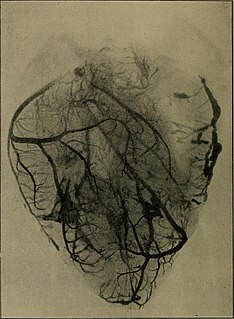Frederick Gardiner FRSE FRCSE FRSM (1874- 8 September 1933) was a Scottish radiologist and dermatologist.
Frederick Gardiner FRSE FRCSE FRSM (1874- 8 September 1933) was a Scottish radiologist and dermatologist.
Gardiner was born in Edinburgh in 1874 the son of John Gardiner and his wife Isabella. [1] He studied medicine at the University of Edinburgh graduating MB CM in 1895. He then worked as a Resident first at Stirling Royal Infirmary, then at Dundee Royal Asylum. [2] He returned to Edinburgh for further study, gaining a diploma in Public Health in 1901. He took on a role as Leith Hospital's radiologist in 1901. He gained his doctorate (MD) in 1902 writing his thesis on x-ray use in pulmonary tuberculosis. [3]
From 1904 he worked as Assistant Physician at the Edinburgh Royal Infirmary. In 1912 he became a senior Physician and also began lecturing in Dermatology at the University of Edinburgh and in extramural classes. [4] He did much to pioneer (in retrospect now seen as a mistake) the use of x-rays in treating of skin diseases. [5] He also worked with Sir Robert Philip on the use of x-rays to diagnose tuberculosis. [6]
He lived close to both University and Infirmary, at 9 George Square in Edinburgh (now demolished). [7]
During the First World War he worked at Bangour Village Hospital advising on issues relating to the skin, and building its later reputation for work on skin grafts for burn victims.
He was elected a Fellow of the Royal Society of Edinburgh in 1923. His proposers were Sir Edmund Taylor Whittaker, Sir James Alfred Ewing, David Gibb, and Arthur Crichton Mitchell. [8]
He died at home in Manor Place, Edinburgh, following a long illness (thought to be skin cancer induced by over-use of x-rays), on 8 September 1933. [9] He was cremated at Warriston Crematorium on 11 September.
See [10]
He was the father of John Percival Gardiner.
Dr Angus Macdonald FRSE FRCPE, was a Scottish physician, obstetrician and lecturer at the University of Edinburgh. He served as President of the Edinburgh Obstetrical Society from 1879 to 1881.
Professor Thomas Jones Mackie FRSE LLD CBE was a noted Scottish bacteriologist; Dean of the Faculty of Medicine, University of Edinburgh; and author of medical research textbooks.
Robert Willis was a Scottish physician, librarian, and medical historian.
Richard Lightburn Sutton Sr. M.D. FRSE FRGS LLD was an American dermatologist. He gives the eponym for Sutton's disease, Sutton's naevus and Sutton's phenomenon.

Sir Thomas McCall Anderson was a physician and a professor of practice of medicine, at the University of Glasgow.

Sir Byrom Bramwell FRSE LLD was an eminent British physician and medical author. He was a general physician, but became known for his work in neurology, diseases of the heart and blood, and disorders of the endocrine organs. He was president of the Royal College of Physicians of Edinburgh.
Prof George Hector Percival FRSE FRCPE (1902–1983) was a British dermatologist, academic author and president of the British Association of Dermatologists.

Sir Robert William Philip was a Scottish physician and pioneer in the treatment and control of tuberculosis.
Sir Derrick Melville Dunlop FRSE FRCP FRCPE FRCSE FDS LLD QHP was a senior Scottish physician and pharmacologist at the forefront of British medical administration and policy-making in the late 20th century. He created the Dunlop Committee which investigates the side-effects of new drugs in the UK.

William Hope Fowler CVO FRSE FRCSE was a Scottish doctor and pioneer of radiology. He was co-founder of the Edinburgh School of Radiology.

Dr Dawson Fyers Duckworth Turner FRSE, FRCPE (1857–1928) was a British pioneer of radiology and patron of the arts, who died of radiation related cancer.

Sir James Ormiston Affleck FRSE was a Scottish physician and medical author.
Robert Cranston Low FRSE FRCPE (1879–1949) was a Scottish physician and dermatologist. He served as President of the British Association of Dermatologists 1936–37.
Sir Frederick Norton Kay Menzies KBE FRSE FRCP LLD was a British physician and public health expert. He was Honorary Physician to King George VI.
Arthur Logan Turner FRCSEd FRSE LLD was a Scottish surgeon, who specialised in diseases of ear, nose and throat (ENT) and was one of the first surgeons to work at the purpose-built ENT Pavilion at the Royal Infirmary of Edinburgh. During his surgical career he published a series of clinical papers and wrote a textbook of ENT surgery which proved popular around the world and ran to several editions. After retiring from surgical practice he pursued his interest in the history of medicine writing a biography of his father and histories of the Royal Infirmary of Edinburgh and the University of Edinburgh. As his father had been before him, he was elected President of the Royal College of Surgeons of Edinburgh. His collection of pathological specimens was donated to Surgeon's Hall Museum in Edinburgh..
Prof Edwin Bramwell FRSE PRCPE LLD (1873–1952) was a 20th-century Scottish neurologist. He was President of the Royal College of Physicians of Edinburgh from 1933 to 1935.

Sir Norman Purvis Walker FRCPE was a Scottish dermatologist, and physician-in-charge of the Skin Department at the Royal Infirmary of Edinburgh. He was also one of the first persons in Britain to benefit from the discovery of insulin as a treatment for diabetes.
Prof Matthew Sydney Thomson FRSE FRCPE (1894–1969) was a 20th-century British dermatologist. With his predecessor August von Rothmund he gives his name to the skin condition, Rothmund–Thomson syndrome. He was affectionately known as "Tommy". He was President of the British Association of Dermatology in 1948.

Douglas Chalmers Watson M.D., F.R.C.P.Ed. was a Scottish physician and writer.
Robert Aitken FRSE PRSSA PBAD (1888–1954) was an early 20th century Scottish physician specialising in dermatology and was an expert on lupus vulgaris. He served as President of the Royal Scottish Society of Arts from 1941 to 1944. He was President of the British Association of Dermatologists from 1949 to 1950.
{{cite journal}}: Cite journal requires |journal= (help)